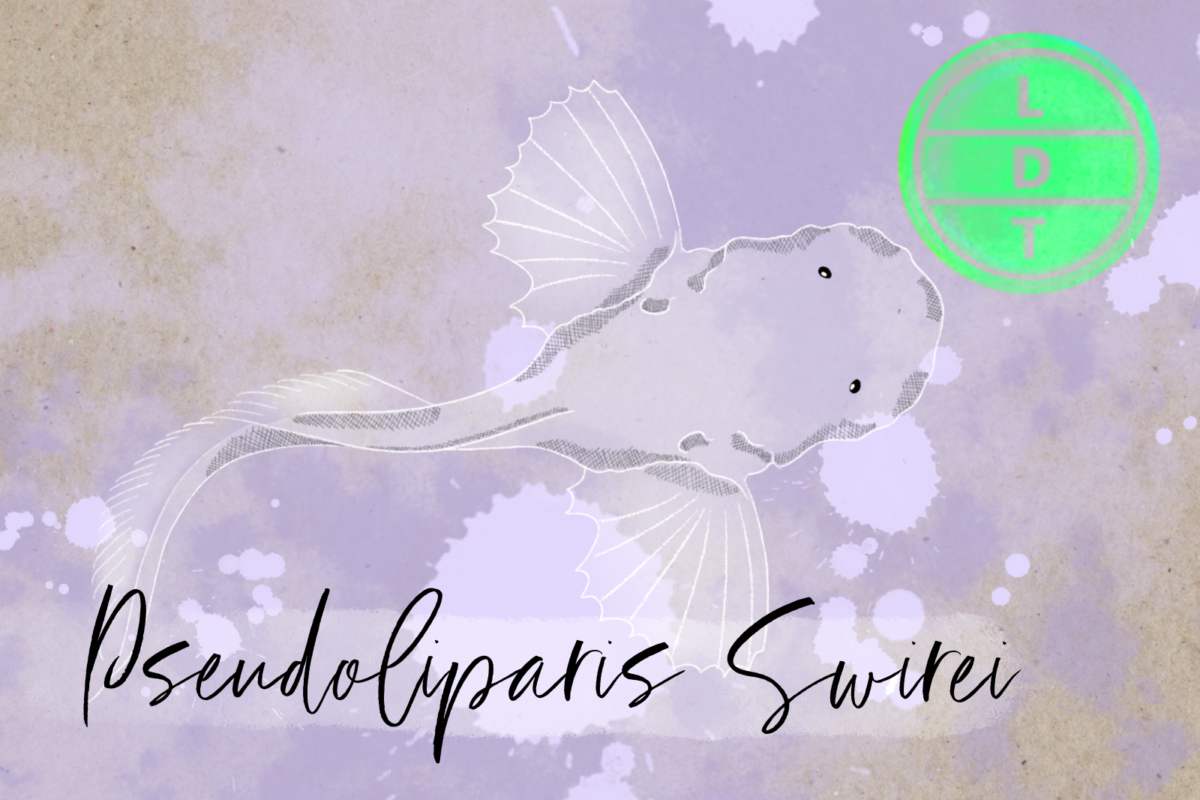“…and today we’re talking about a hole in the bottom of the sea. More on that later.”
When you’re under a lot of pressure, you may get a headache. But you’ve never been under as much pressure as the Mariana snailfish. Most things at the bottom of the ocean are invertebrates. They live the squishy life. But our friends the snailfish is boney, and they need some interesting genes to survive in the deepest parts of the ocean. It just goes to show that those who thrive under pressure are right for the job in Life, Death, and Taxonomy.
Description
- The Mariana Snailfish is shaped like a tadpole with broad pectoral fins.
- Their tail fin is tapered to a point like a tadpole.
- They are a light tan to white color and they have no scales.
- Their lips and chin are dimpled, and their fins are serrated.
- Looks like a loogie someone hacked up after drinking a bunch of milk–no further questions.
- It’s an albino tadpole with translucent skin, a bulging stomach, and beady black eyes.
- Its tail is longer than the rest of its body and it has two pectoral fins that help it navigate the ocean floor.
Measure Up
Welcome to the beloved Measure Up segment. The official listener’s favorite part of the show! The part of the show when we present the animal’s size and dimension in relatable terms through a quiz that’s fun for the whole family. It’s also the part of the show that’s introduced by you when you send in audio of yourself saying, singing, or chittering the words Measure Up into ldtaxonomy at gmail dot com. We don’t have a measure up intro, so we’ll look back in the archives for our greatest hits.
Length
- 28.8 cm (11.3 in)
- How many Mariana Snailfish go into the depth of the deepest submarine dive ever?
- Hint: The dive was made in 2019 by Victor Vescovo. You can watch the dive on Discovery’s documentary “Deep Planet.” Vescovo was solo in a submersible that went into the mariana trench. He saw several rarely seen species, including the Mariana Snailfish.
- 38,069 fish. The dive was 35,849 feet (10,926.7 meters) down, more than the height of Everest.
Weight
- 160 g (0.35 lb)
- How many Mariana Snailfish go into the largest bowl of spaghetti?
- Hint: The bowl was made by Buca di Beppo in Garden Grove, CA in 2010. It was 15 feet in diameter and 3.5 feet deep.
- 39,388 fish. The bowl was 13,786 lbs (6,253 kg).
Fast Facts
- Different species of snailfish can be found in the deepest depths all the way up to tide pools.
- The Mariana species was first found and caught in 2014.
- Deep sea snailfish are often top predators in their area, where competition is low.
Fast Facts
- Range: Absolute bottom of the ocean. Lives in the hadal zone of the Mariana Trench in the Pacific Ocean.
- Very few of these guys have ever been caught since they’re so far down there. The first one of these guys was caught in 2014.
- One was caught at a depth of 26,135 ft, likely the record for the deepest fish catch ever. Other fish have been caught in nets that went lower but the actual fish could have been at a higher elevation.
- Only one other fish we know of survives at this depth, and it’s also a snailfish.
- Diet: They eat little crustaceans and shrimp that they find in the trench.
Major Fact: Good Under Pressure
Mariana snailfish are the deepest living fish species that we have ever discovered. In fact, researchers believe that they may live at the maximum depth that a fish species can withstand.
These fish live at depths of 8,000–8,500 m (26,200–27,900 ft). The bottom of the marian trench is 36,201 feet, where the pressure is 16,000 PSI. Your house is likely 14 PSI.
Snailfish that live at these depths have some interesting adaptations to help with high-pressure situations.
Snailfish that live in the deep sea tend to have larger eggs, and they lay fewer eggs at different times of the year. The unusually large eggs are 9.4 mm (0.37 in) in diameter. We believe that larvae hatch and spend time in more shallow water around 1,000 meters. Snailfish species that live among king crabs lay their eggs in king crab gills for protection. No idea how they manage to do this.
They also have partially cartilaginous skeletons that are flexible and useful for life under immense pressure. A gene mutation prevents early calcification of their cartilage, which keeps them flexible and fractures under immense pressure.
They also have holes in their skulls that help compensate for pressure. You and I and everything that has a skull on land has a closed skull. This protects your brain and allows you to maintain a constant intracranial pressure. However, if you lived with a Mariana snailfish, the difference in pressure between your head and the ocean around you would crush your skull.
An open skull provides some structure and protection for fish brains, but it also allows their head pressure to equalize with their environment. The gene that prevents cartilage calcification may be responsible for the irregular swiss cheese skull in these fish.
Ending: So get the jumbo-sized eggs, don’t be ashamed of having translucent skin, and don’t complete your bone ossification if at all possible like the Mariana snailfish here in LDT.

